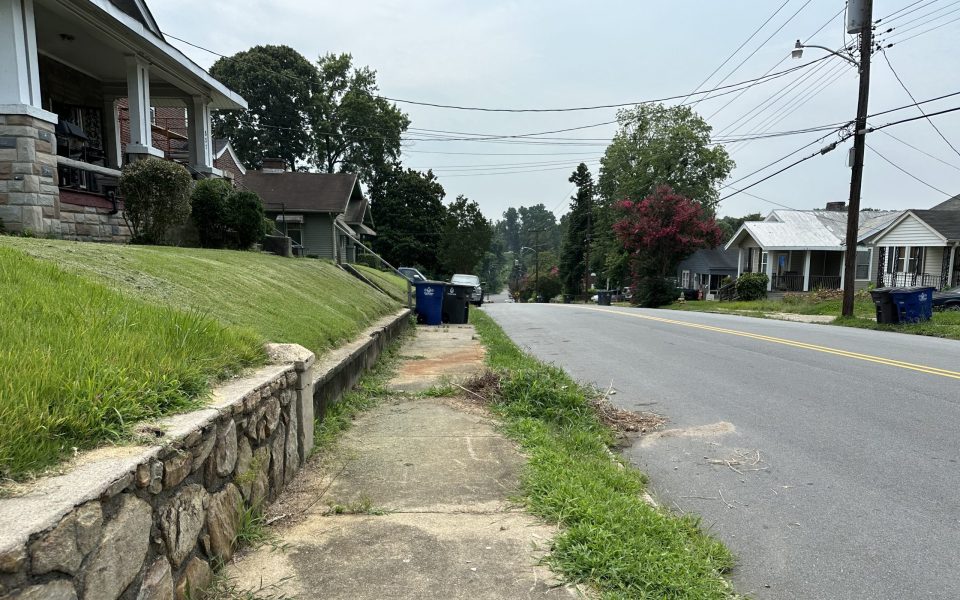On a baking July afternoon, Maurice Sherard sits outside his home in the 90-degree weather, watching as cars and passersby float down the street. Sherard lives in the Winston-Salem neighborhood known as Reynoldstown.
Houses sit close together and have limited parking space. The slim roads leave little room for street parking, so cars are often parked over the curb and onto the sidewalks in order to leave room for drivers. Many of the sidewalks are narrow, uneven and overgrown with weeds. Not much space is left for garbage bins, which also sometimes obstruct the paths. Some sidewalks are less shaded than others; crosswalks are a rare sight in the area.
For the retired and elderly population like Sherard, it’s not so easy to get around.
That’s why the East Ward’s council member Annette Scippio has requested staff assistance in conducting walking audits within the Reynoldstown and Slater Park neighborhoods to increase pedestrian access in the areas. The information item was on the consent agenda during a June 13 meeting of the Public Works Committee.
Scippio has targeted the month of October for the two proposed walking audits.
At the end of the audit, each neighborhood will have a report that lists deficiencies that need to be addressed in order to improve walkability. The reports will be used by staff to address maintenance and repair needs. According to city documents, it’s likely that the amount of the city’s Department of Transportation staff time needed would only be 2-3 hours per neighborhood.
What is a walkability audit?
The American Association for Retired Persons, or AARP, offers a toolkit that the city would use to evaluate the walkability of its neighborhoods. During an audit, walkability is evaluated by how safely pedestrians can travel along a street, navigate an intersection, get from one place to another and more. The toolkit allows volunteers from the neighborhoods to provide a block-by-block audit of issues that contribute to the walkability of the area.
According to the toolkit, audit activities can include counting cars that pass the location, counting pedestrians who walk along or cross the street, noting demographic characteristics of the pedestrians such as age and physical ability, timing how long the traffic light stops vehicles so pedestrians can cross, or assessing why people are walking in the location — if they’re exercising, commuting, shopping, etc. Details to focus on include crossing signals, overhead traffic lights, turning lanes, curb cuts, crosswalks and vehicle stop lines, sidewalks and lighting. Residents like Sherard are also concerned about safety when walking at night.
“I wouldn’t be a woman and walking by myself, I’ll put it like that,” Sherard said, adding that he doesn’t feel comfortable walking at night either.
Sherard also notices the parking situation.
“Yeah, sometimes they do, sometimes they park like that.”
But Sherard doesn’t drive at all, he says.
“All these cars you see around here,” Sherard said, chuckling, “they don’t belong to me.”
The neighborhood is also bordered by New Walkertown Road, a thoroughfare with several lanes that has cars zipping left and right, flanked by thin sidewalks. Around the neighborhood, a convenience store sits at the corner of 12th Street and North Cameron Avenue. From there, it’s a half mile walk to a Food Lion and other resources such as a bank, pharmacy and more. It’s just a matter of getting there.
Between Gray Avenue and the intersection of North Cameron Avenue and 8th Street, overgrown weeds currently obstruct the sidewalk running along Mount Zion Place. There are also places where the sidewalk is bumpy — for example, on North Jackson Avenue. Heading east on 11th Street toward North Cameron Avenue, there’s a steep incline. For a pedestrian with a walker or a cane, these obstacles can pose a challenge. According to WalkScore.com, Winston-Salem’s average walkability score is 22, while Greensboro’s is 29. The neighborhood of Reynoldstown has a walkability score of 56 while downtown has a walkability score of 79 and sits approximately a mile and a half away.
All CityBeat reporting content is made possible by a grant from the NC Local News Lab Fund, available to republish for free by any news outlet who cares to use it. Learn More ↗
Republish this storyJoin the First Amendment Society, a membership that goes directly to funding TCB‘s newsroom.
We believe that reporting can save the world.
The TCB First Amendment Society recognizes the vital role of a free, unfettered press with a bundling of local experiences designed to build community, and unique engagements with our newsroom that will help you understand, and shape, local journalism’s critical role in uplifting the people in our cities.
All revenue goes directly into the newsroom as reporters’ salaries and freelance commissions.


Leave a Reply